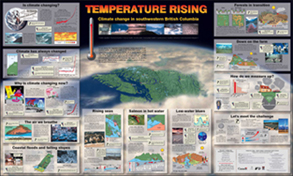
Natural Resources Canada > Earth Sciences Sector > Priorities > Climate Change Impacts and Adaptation > Curriculum Tools
Climate Change in Canada - Curriculum Tools
Science - S2 - Teacher's Resource Temperature Rising: Climate Change in Southwestern British Columbia
Please note: These exercises are not designed to be filled out nor printed from your Web browser. Please download and print the PDF files located at the bottom of the page.
Trivia Challenge:
Search the entire poster to find answers for the following:
- What animals are diagrammed as methane producers?
- How thick was the glacier on top of Vancouver 16 000 years ago?
- What monster is said to inhabit Okanagan Lake?
Did You Know?
Use the pieces of information under this heading ("Did You Know?") on the poster to answer the following true/false (T or F) questions. If the statement is false, cross out the incorrect word or number value, and write in the correct version.
Hydroelectric reservoirs supply 50% of B.C.'s electrical needs.
Canada has about 4% of the world's population, but produces 2% of global CO2 emissions.
The cost of fighting B.C.'s forest fires during the 1998 summer was $120 million.
The 1980's was the warmest decade of the last century.
9000 years ago, average temperatures in southern B.C. were 1 - 2 ║C warmer than today.
The 1948 Fraser River Flood cost an estimated $100 million.
Mackerel may eat young salmon.
On average, each person uses over 100 L of water at home every day.
Motor vehicle exhaust is the source of nearly 30% of the greenhouse gas emissions in the lower Fraser Valley.
The atmosphere of Venus is 75% CO2.
Is Climate Changing?
- How does weather differ from climate?
- How do glaciers behave when climate changes?
- By how much is the global temperature expected to rise above 1980 levels by the year 2100?
- Where does the global map indicate the most significant temperature changes will occur?
Climate Has Always Changed:
- What kind of biodiversity would you expect to have inhabited the Vancouver area 16 000 years ago?
- Examine the global temperature change over 10 000 years. What seems to be the trend toward the year 2100?
- When did the Little Ice Age occur?
- Do you think extrapolating the graph from 1998 shows a probable increase? Why or why not?
Why is Climate Changing Now?
- Record the following percentages of incoming solar radiation:
____% absorbed by atmosphere
____% reflected by atmosphere
____% absorbed by Earth's surface
____% reflected by Earth's surface
- Summarize the carbon balance diagram.
- What turning point saw additions of CO2 to the atmosphere overtake removals?
- Aside from water vapour, what are "the big three" GHGs?
-
-
-
- What are the causes of the rapid build-up of CO2 in our atmosphere?
- Examine the graph on atmospheric CO2 concentrations.
- How many ppm CO2 are currently in our atmosphere?
- What is the projected concentration for the year 2050?
The Air We Breathe:
- What gets trapped in the Fraser Valley?
- What will happen to the number of "bad air" days as climate warms?
Coastal Floods and Failing Ships:
- Wetter and stormier winters are predicted for coastal B.C. Predict what impact this might have on the skiing industry in B.C.
- Are slopes more or less at risk with wetter winters? Explain.
Rising Seas:
- As climate warms, what will happen to glaciers?
- What areas are most vulnerable to rising sea levels?
- Answer the "?" regarding restricting development along shorelines.
- Explain what is meant by "coastal squeeze".
Salmon in Hot Water:
- Why might tuna and mackerel replace salmon stocks in southern B.C.?
- How might a reduction in salmon affect B.C.'s economy?
- Create a "human stress-o-meter" to temperature, similar to the one for salmon.
Low-Water Blues:
- What industry will largely be affected by changes in river flow with climate warming?
- How much more water is used in an average home for showers than for baths?
- What units are river flows reported in?
- What date typically sees the Similkameen River's highest flow rate?
- Explain what is meant by "evapotranspiration".
- As evapotranspiration increases, what happens to the summer watertable?
Forests in Transition:
- Answer the "?" in the centre of this frame.
- Approximately how far is Kamloops from Hope, B.C.?
- Which of these 2 regions (Kamloops/Hope) do you think will be more affected by climate warming, and why?
- What impact will climate warming have on the B.C. forest industry and economy?
Down on the Farm:
- Explain why the impacts of warming will have "mixed blessings" for the interior?
- How will climate warming affect impacts on crops by pests?
- If you were a greenhouse owner, how would your expenses shift throughout the year from present day?
- What do you think the overall impact will be to the average B.C. farmer's income?
How Do We Measure Up?
- Rank these countries (1 - 9) by 1995 CO2 emissions:
____ Canada
____ Latin America
____ India
____ U.S.S.R.
____ China
____ Africa
____ Japan
____ Australia
____ U.S.
- Approximately how many citizens of India have the same impact as one Canadian in CO2 emissions?
- Out of individual household CO2 emissions, what % does automobile use put out?
- What activities contribute to 75% of CO2 emissions that are not individually produced?
Let's Meet the Challenge:
- What did Margaret Mead say?
- What does she mean?
- Generate a list from group members, outlining what we as individuals can do to help reduce our personal impact on climate change:
Downloads:
| 
